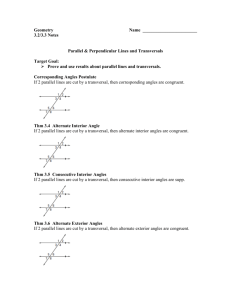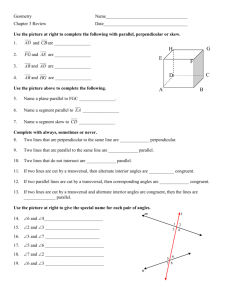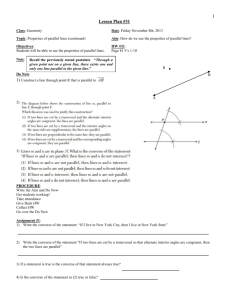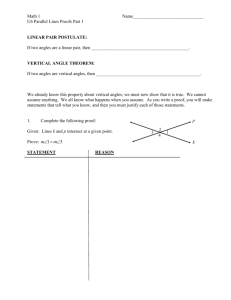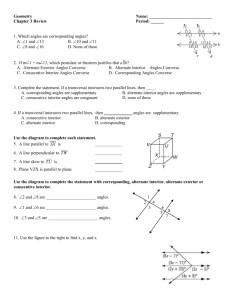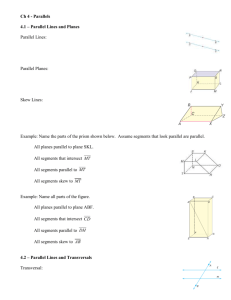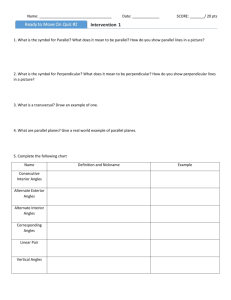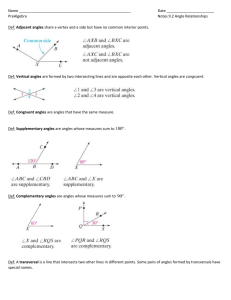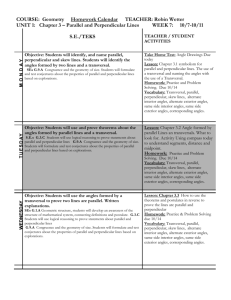Example
advertisement
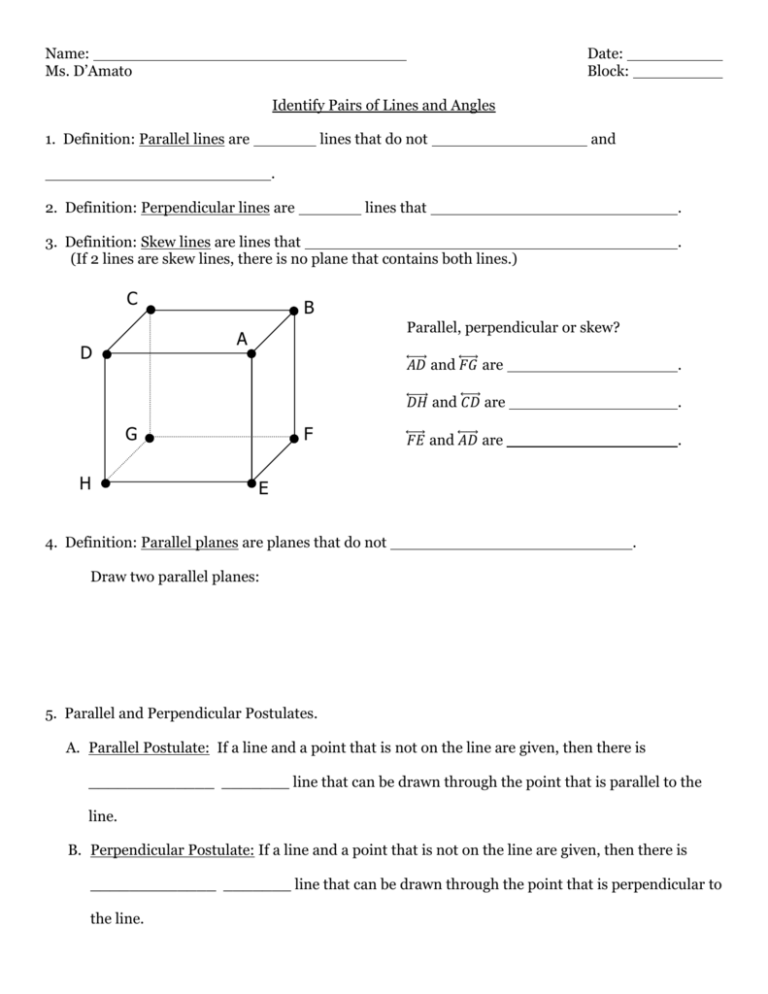
Name: Ms. D’Amato Date: Block: Identify Pairs of Lines and Angles 1. Definition: Parallel lines are lines that do not and . 2. Definition: Perpendicular lines are lines that . 3. Definition: Skew lines are lines that (If 2 lines are skew lines, there is no plane that contains both lines.) C B Parallel, perpendicular or skew? A D G H . F ⃡ and 𝐹𝐺 ⃡ are 𝐴𝐷 . ⃡𝐷𝐻 and ⃡𝐶𝐷 are . ⃡ are ⃡𝐹𝐸 and 𝐴𝐷 . E 4. Definition: Parallel planes are planes that do not . Draw two parallel planes: 5. Parallel and Perpendicular Postulates. A. Parallel Postulate: If a line and a point that is not on the line are given, then there is _____________ _______ line that can be drawn through the point that is parallel to the line. B. Perpendicular Postulate: If a line and a point that is not on the line are given, then there is _____________ _______ line that can be drawn through the point that is perpendicular to the line. 6. Definition: A transversal is a . 7. Be able to identify these types of pairs of angles: a. b. c. d. e. Corresponding s Alternate interior s Alternate exterior s Consecutive interior s (sometimes called same-side interior s) Consecutive exterior s Example: Use the diagram at the right to name all the pairs of: a. Corresponding s: Occupying corresponding positions ____________ ____________ ____________ ____________ b. Alternate exterior s: ____________ c. Alternate interior s: ____________ 1 3 Lying outside the two lines on opposite sides of the transversal ____________ 5 8 2 4 6 7 Lying between two lines on opposite sides of the transversal ____________ d. Consecutive interior s: Lying between the two lines on the same side of the transversal ____________ ____________ e. Consecutive exterior s: Lying outside the two lines on the same side of the transversal ____________ ____________ Use Parallel Lines and Transversals 8. Postulate: If two parallel lines are intersected by a transversal, then the corresponding angles are congruent. t See the diagram at right. If we know that l // m, then we can conclude that: , 2 1 3 , l 4 5 , 6 m 8 7 . Trick: . 9. Theorem: If 2 lines are parallel, then alternate interior s are congruent. Examples: a. If a // b, then: a , 1 4 and b 2 3 5 8 b. If a // b and m3 = 60, then m1 = 6 7 . m2 = _______, m4 = _______, m5 = _______, m6 =_______. Trick: . 10. Theorem: If 2 lines are parallel, then consecutive interior s are . Examples: a. If l // m, then 4 supp and 3 supp . b. If l // m and m4 = 70, then m5 = Trick: . . 1 2 4 3 5 6 8 7 l m 11. Theorem: If 2 lines are parallel, then alternate exterior angles are congruent. 1 Examples: a. If c // d, then 1 ≅ and 2 ≅ 4 . 3 2 c 5 6 8 7 b. If c // d and m1 = 150, then m7 = ________. d 12. Consecutive exterior angles: If two parallel lines are cut by a transversal, then the following pairs of angles are supplementary. (not a theorem) t Examples: a. If l // m, then 1 supp and 2 supp b. If l // m and m1 = 55, then m7 = . . 2 1 3 l 4 5 6 7 8 13. Theorem: If a transversal is to 1 of 2 parallel lines, then the transversal is to the other line also. Examples: a. Draw m a and a // b. b. Is m b? c. If lines c and d are parallel and line t is drawn perpendicular to d, then what conclusion can you make? Draw a diagram. **Do not forget about vertical angles (equal) and linear pairs (supplementary)** m
